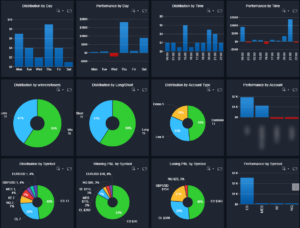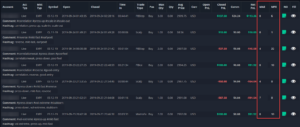Home › Market News › You Should Have a Trading Journal. So Why Don’t You?
Every educator worth their salt will tell you, it’s important to journal your trades, to keep a record so you can track your progress.
However, almost all traders fail to heed this advice. In fact, of the traders I work with, I’d say that less than 5% keep a consistent trade history. It’s not just laziness at play here; there are practical and psychological reasons that make keeping a journal a challenge.
Let’s start by looking at some of the reasons you might avoid journaling your trades.
When is it best to enter this information on your trading notes? Well, the sooner, the better, especially because that’s when the way you feel about the trade is clearest in your mind. So as soon as you enter, you can start to log the information. Trouble is; that’s also the time that you need to focus the most on managing your trade.

Most successful traders are compulsively organized—at least when it comes to actual trading
The logging can interrupt the trading. Once you have breathing room in a trade, you have more time to enter the details. The flip side is that if you don’t enter the information right away, and leave it until later, and the trade is a loser, you might decide “hey, this one doesn’t count” and omit its notes completely. You might forget key elements too “it kept coming back to 2050, and nobody wanted to sell there” – those key details are important. It’s better to get something down quickly, even if you come back and fill in more details later.
Tiger Woods didn’t get a hole in one the first time he hit a golf ball. Trading is a skill, and very few people are great at anything when they first start. Any new setup you employ will take time to perfect. You need to journal your trading even when you aren’t a great trader. It’s a tool for self-improvement, not an exercise in massaging your ego.

Bad days happen to the best of us, especially when you’re starting out
So yes, you will invariably start the journaling process by writing down a lot of bad trades—trades where you got in because you were bored, setups that didn’t work, and trades you held onto when the market was obviously against you.
There is no fun in that. It’s like writing down, “I suck” 1,000 times. But remember, your journal is your friend; it’s just giving you a bit of tough love. If you persist, it will eventually keep you on the straight and narrow.
You don’t have time for it. You are entering trades every 3 minutes, you also have a full-time job, and your wife is nagging you to change the light bulb in the toilet. Many people are addicted to trading. I remember one trader mentioning that he had his trading PC in his bedroom, and if he woke up in the middle of the night for a call of nature, he’d check his positions. This is not healthy.
The simple answer for those that feel journaling is an intrusion on their trading time is “spend less time trading.” It’s far better to trade a little less, but give yourself a chance to improve than to trade all your spare time without taking a step back to review.

The average trader has something like 1,274 things to be doing at any given moment
For those of you that are not yet profitable, a simple journal entry and a little commitment might not make you profitable, but it WILL help you understand what is working, what isn’t, and where your focus needs to be. Acting upon that information is the next hurdle.

Journaling isn’t something specific to trading; it helps with many endeavors – recording your food intake and exercise on a diet, recording your performance in sports. It helps in long term endeavors where you need to improve over time with consistent practice.
Part of the benefit of journaling is tracking the results and monitoring the changes in performance, but it also appears that journaling helps you to stay on track. Studies have shown that people on a diet that journal are far more successful than those that don’t. It’s as if the journal is your big sister looking over your shoulder, keeping you inline.
Let’s consider what information you should have in your journal:
It seems like basic and obvious information. Time is very important, especially when compared to open/close times. A trade taken 15 minutes after the open may have a different hit rate from a trade taken one hour after the open. The last 15 minutes of a market display markedly different actions than the middle of the day. You cannot ignore the fact that we have an Asian Session, European Session, and US Session and that trading across those open/close times produces different actions in certain markets.


Figure 1 – You can see your performance by day, time, and instrument.
If you have several different ways or reasons to enter the market, some may work better than others. It makes sense to categorize your setups to be able to weed out or refine the ones that don’t work so well. Let’s assume that the ‘setup’ includes both the reason you enter AND the way you would manage out the trade, set your stops & targets.

Figure 2 – You can see the trade types you created and their performance
MAE = Maximum adverse excursion AKA “How far did it move against me.” MFE = Maximum Forward Excursion AKA “How far it moved my way” and your actual Profit. You may be scaling into or out of trades too, so you’ll need to record that info. MFA and MFE help you fine-tune your stops & targets.

Figure 3 – Within the list of your trades, you can easily track all the important data of your trades
The trading notes are perhaps the most important part of your trading journal. How did you feel about the trade? Why you took it and why you didn’t follow your rules?
Was the market in a range or trending? Was volume above average? Were correlated markets/market internals supporting the trade? Had news just been announced? It is very important to make a note of how volatile the market was as volatility tends to change throughout the year. Some setups may work better in slower periods.
You may find you would do well if you didn’t keep hitting into the market when your ‘gut’ told you to. You may find that you entered the market well but saw a move against you and didn’t get out according to plan and “hoped” it’d come back. It could be that the off-plan trades are your best, but it’s imperative to be able to compare trades that followed your plan to those that didn’t.


Figure 4 – It will be on your Notes that you will log all the information we discussed above. To facilitate the logging of all this information, you can create hashtags and study their performance.
Once you have your journal, you can use it to assess your progress.
Journalytix was born out of the necessity to have an automatic system that could remove part of the trader’s difficulties in maintaining an accurate journal of his trades.
With Journalytix, the trader can easily, with one mouse click, run statistics on his trades without the need to spend hours around Excel, trying to understand how to import his trades and how to code all formulas to calculate the data he needs.
But Journalytix is more than a simple journaling platform; it’s also a traders hub, where he can find all his daily information; news, economic calendar, trade statistics, all updated in real-time.
For those of you that are not yet profitable, a simple journal entry and a little commitment might not make you profitable, but it WILL help you understand what is working, what isn’t, and where your focus needs to be. Acting upon that information is the next hurdle.
Please visit www.journalytix.me to find out more.
Peter Davies is Jigsaw Trading CEO and an active order flow trader in emini S&P 500 futures.
